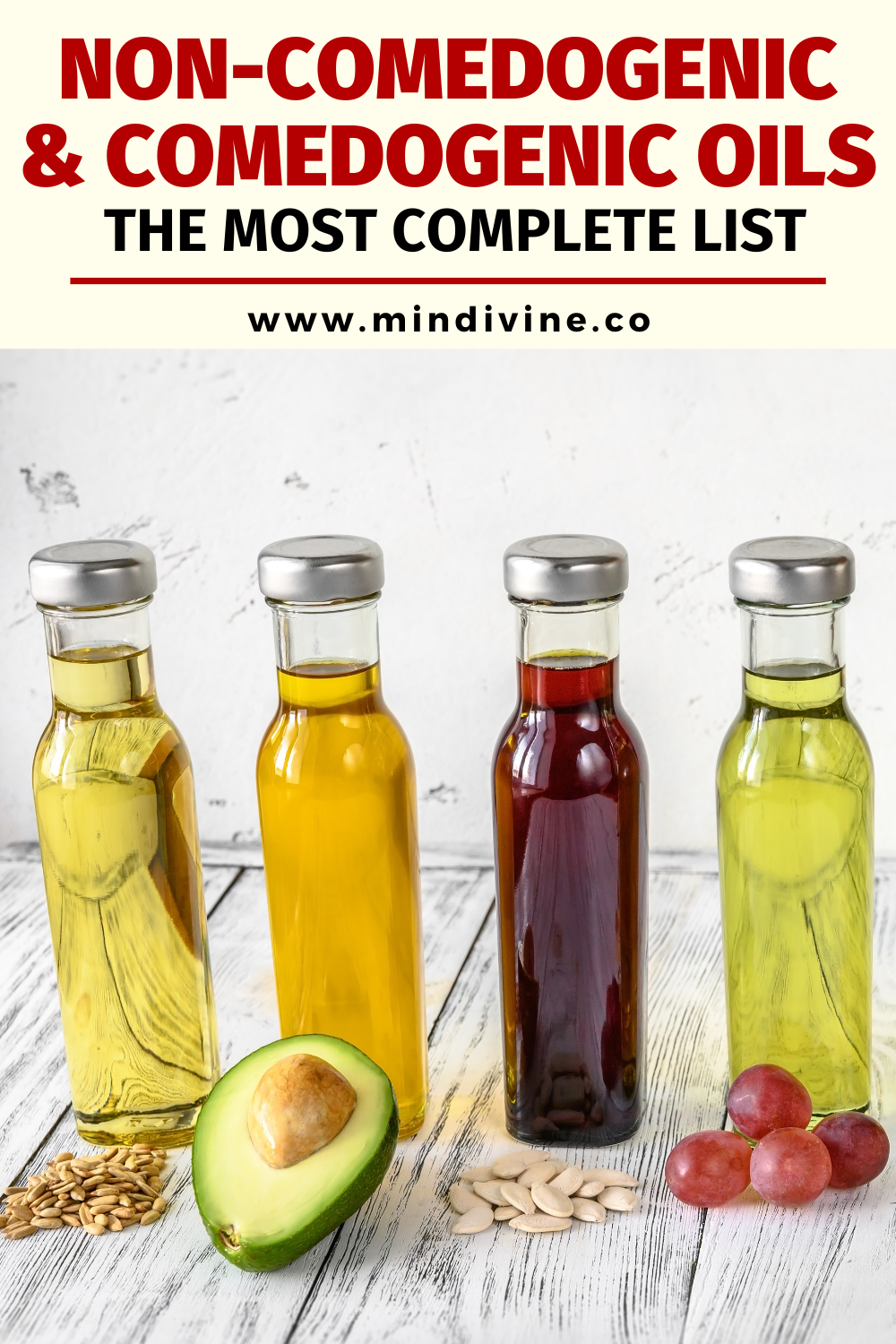Many of us look for information on vegetable oils for skincare and usually ask ourselves: for my skin type, are comedogenic or non-comedogenic oils better? Will this oil be good for my skin?
With this objective in mind, I set out to write this post that covers as many comedogenic and non-comedogenic oils as possible. It is a guide in which I will show you the comedogenicity of each oil, for which type of skin it is suitable, and what are its most outstanding benefits. But first, I will tell you very briefly, in case you don’t know, what the comedogenic scale is and how it can help you choose the ideal oil for your skin.
Comedogenic Oils and Non-Comedogenic Oils
What is the comedogenic scale?
The comedogenic scale in oils is based on classifying on a scale of 0 to 5 the possibility that certain oils, as well as butters, can obstruct the pores of the skin, according to their comedogenic components.
So a person who is prone to acne breakouts should avoid highly comedogenic oils.
However, people with drier skin may prefer oil that is more in the middle of the comedogenic table.
I will now explain very briefly how the oils are classified according to the comedogenic scale:
- Comedogenic rating of 0: considered non-comedogenic and therefore does not clog pores.
- Comedogenic rating of 1: indicates a small chance of oil clogging the pores, but this is very low.
- Comedogenic rating of 2: indicates that the oil should not normally clog the pores in most cases, with the possibility of this occurring being moderate to low.
- Comedogenic rating of 3: has a medium to moderate chance of clogging skin pores, generally depending on skin type.
- Comedogenic rating of 4: for most people, an oil with this rating will tend to clog their skin pores.
- Comedogenic rating of 5: in this case, it is normal for oil with this rating to clog the pores of the skin. Very few people can tolerate oils labeled with this rating.
Oils considered “non-comedogenic” are those that have a comedogenic rating of 2 or less, while virtually any oil with a rating of 5 will be highly comedogenic and tend to clog pores and cause an acne breakout.
How to Know if a Product is Comedogenic
However, there are many factors, in addition to its comedogenicity, that influence whether oil can clog the pores of the skin, since each skin is different and, in many cases, the same oil in different people with different skin types can react differently.
Among the factors that can influence this are:
- The type of skin.
- The disease or problem being treated.
- Water intake.
- Environmental factors.
- Other factors can influence how the oil acts on the skin.
It is always recommended that you consult your doctor before using any vegetable oil, especially if you suffer from any disease or allergy.
Furthermore, apart from the comedogenic classification of oil, another factor that will determine how oil will act on skin with certain characteristics is the composition of the fatty acids.
Therefore, I will now give you the comedogenic rating of the most used oils for skincare, and I will also detail their fatty acid composition.
The List of Comedogenic and NonComedogenic Oils
Without further ado, here is the complete list of comedogenic and non-comedogenic oils.
Abyssinian Oil
– Comedogenic classification: 1
– Fatty acid compounds:
- Linolenic acid: 2 to 5%
- Linoleic Acid: 7 to 15%
- Oleic acid: 10 to 15%.
- Erucic acid: 50 to 65%
Abyssinian oil is suitable for oily and normal skin, among other things, because of its rapid absorption.
It is considered a very stable oil, like jojoba oil, because it contains a high amount of erucic acid, which gives it great emollient properties.
This is why it is ideal for dispersing nutrients on the skin, especially when combined with essential oils.
This oil is a very good moisturizer and helps to balance the texture and tone of the skin.
Acai Berry Oil (also known as Asai Palm Oil)
– Comedogenic classification: 2
– Fatty acid compounds:
- Stearic acid: 2 to 10%
- Palmitic acid: 8 to 15%
- Linoleic Acid: 20 to 40%
- Oleic acid: 35 to 55%.
Acai Berry oil is an ideal oil for dry skin types because it contains a combination of omega-3, 6, and 9 that gives it great moisturizing properties.
So it is suitable for dry, mature, and damaged skin, especially when there are skin conditions such as eczema or psoriasis.
It also has antioxidant and anti-inflammatory properties.
This oil helps soothe irritated skin, prevents moisture loss, minimizes the appearance of wrinkles, and is also a good emollient easily absorbed by the skin.
Avocado Oil
– Comedogenic classification: 3
– Fatty acid compounds:
- Linolenic acid: 0.8%
- Linoleic acid: 15%
- Oleic acid: 65%.
Avocado oil is mainly suitable for the driest skin types, but it should be noted that it can clog pores.
However, for those with skin that can tolerate it, it is very moisturizing and a great conditioner for skin tone and texture.
It also helps reverse the signs of aging and treats conditions such as psoriasis and eczema.
Apricot kernel oil
– Comedogenic classification: 2
– Fatty acid compounds:
- Linolenic acid: 0.22%
- Linoleic acid: 23%.
- Oleic acid: 70%.
Apricot kernel oil is ideal for dry skin because it is very well absorbed.
It is also anti-inflammatory, anti-aging, antibacterial, and antioxidant and therefore helps, among other things, to fight the bacteria that cause acne.
Cottonseed Oil
– Comedogenic classification: 3
– Fatty acid compounds:
- Linolenic acid: 1%
- Oleic acid: 19 to 35%
- Linoleic acid: 42 to 54%.
Cottonseed oil, while not really a marvel for skincare, is mentioned here because it is oil used by some people. It is used for cosmetic purposes because it is good for restoring the skin’s lipid barrier and has a high concentration of vitamin E.
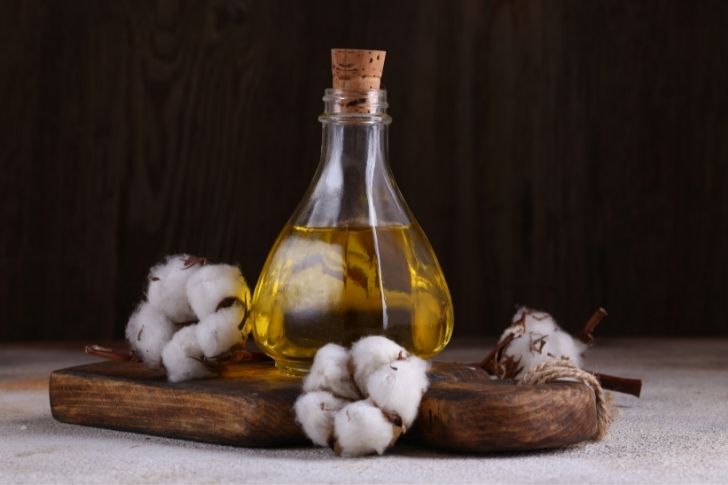
Due to its intermediate comedogenic classification, it is not very recommended for oily skin since it can cause some acne outbreaks, but rather ideal for dry and irritated skin.
It is widely used as an ingredient in the preparation of soaps and some industrial cosmetics such as shampoos and eye makeup.
Sweet Almond Oil
– Comedogenic classification: 2
– Fatty acid compounds:
- Linolenic acid: 0.4%
- Linoleic acid: 20 to 30%
- Oleic acid: 62 to 86%.
Sweet almond oil is very useful when there are sensitive skins that are dry and irritated, and prone to acne because it has great emollient properties.
It is also good for regenerating the cells because it penetrates into the damaged cells and repairs them, also favoring improved hydration.
Amaranth Oil
– Comedogenic classification: 2 to 3
– Fatty acid compounds:
- Stearic acid: 3%
- Palmitic acid: 19%.
- Oleic acid: 23%.
- Linoleic acid: 50%.
Amaranth oil contains high amounts of squalane, which is one of the most common lipids produced by the skin, making it ideal for moisturizing and preventing aging, thanks also to being a great antioxidant.
It is usually good for the more resistant oily skins, although due to its comedogenic qualification, it can cause obstruction of the pores in some people.
Amla Oil
– Comedogenic classification: 1
– Fatty acid compounds:
- Oleic acid: 26%.
- Linoleic acid: 51%.
Amla oil has a good amount of vitamin C, flavonoids, polyphenols, and minerals that make it very nutritious for the skin, promoting good health.
It is widely used in India because it helps to improve the appearance of the skin, renewing and beautifying its texture and tone.
It is good for most skin types, preventing spots, hyperpigmentation, aging, expression lines, and wrinkles, in addition to being slight protection against sun rays.
Andiroba Oil
– Comedogenic classification: 2
– Fatty acid compounds:
- Stearic acid: 5 to 10%.
- Palmitic acid: 10 to 20%.
- Linoleic Acid: 25 to 30%
- Oleic acid: 45 to 55%.
Andiroba oil is very good for dry and irritated skin that is prone to acne because it is a good emollient and moisturizer.
It has a bright golden color and a very pleasant fruity aroma.
It helps calm and controls irritation and lesions caused by acne breakouts.
Argan Oil
– Comedogenic rating: 0
– Fatty acid compounds:
- Linolenic acid: < 0.5%
- Linoleic acid: 37%.
- Oleic acid: 43%.
Argan oil is suitable for most skin types and, having a comedogenic rating of 0, is very good at repairing damaged skin without clogging pores.
It helps treat acne because it is excellent for regulating sebum production and preventing new outbreaks. In addition, thanks to its vitamin E content, it helps eliminate scars caused by acne while also softening the texture of the skin.
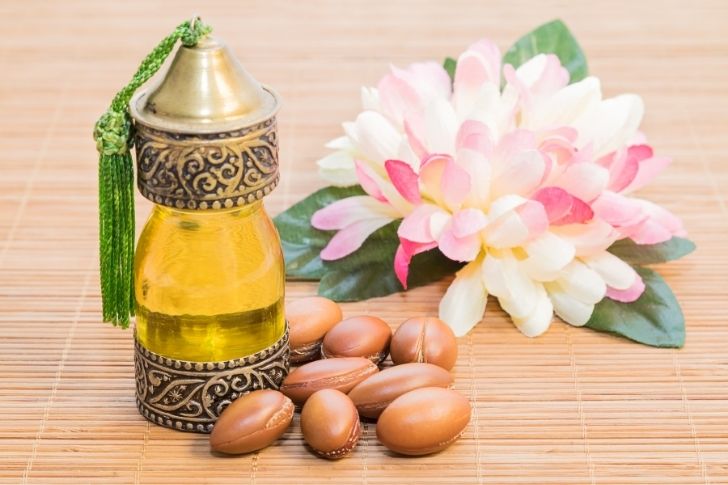
Hazelnut Oil
– Comedogenic classification: 1
– Fatty acid compounds:
- Linolenic acid: 0.5%
- Linoleic Acid: 7 to 15%
- Oleic acid: 68 to 85%
Hazelnut oil, although suitable for most skin types, is especially useful for sensitive skin prone to acne, as it is very good for treating it.
It is an astringent oil that helps to soften and tighten the skin, as well as kill bacteria, thanks to its great antibacterial properties.
It reduces pimples and is a very good moisturizer and rejuvenator.
It also provides protection against the sun’s rays, thanks to its high content of antioxidants.
Oat Oil
– Comedogenic classification: 1 to 2
– Fatty acid compounds:
- Oleic acid: 35 to 43%
- Linoleic Acid: 35 to 43%
Oat oil is a well-balanced oil that is an excellent emollient and a great anti-allergic, anti-inflammatory, and anti-irritant.
It is recommended for all skin types, although it is especially beneficial for sensitive, irritated, and/or damaged skin, thanks to being a great natural soother and being rich in vitamin B and minerals such as zinc, giving them back their elasticity and firmness.
This oil has a very low probability of clogging the pores and is also very easily absorbed.
It is usually recommended to use it mixed or combined with other carrier or base oils.
Babassu Oil
– Comedogenic classification: 1 to 2
– Fatty acid compounds:
- Linoleic acid: 3%
- Oleic acid: 15%
- Myristic acid: 17%.
- Lauric acid: 42%
Babassu oil is not very comedogenic, which is why it is excellent for calming inflamed skin conditions such as psoriasis, eczema, rosacea, and acne.
It is suitable for most skin types, being moisturizing, soft, and light, and it is absorbed very well.
Babassu oil helps soothe the itching and redness of inflamed skin.
Borage Oil
– Comedogenic classification: 2
– Fatty acid compounds:
- Palmitic acid: 9 to 12%
- Oleic acid: 18%
- Gamma linolenic acid: 20%
- Linoleic acid: 39%.
Borage seed oil is really an incredible skin regenerator, thanks to its high content of gamma-linolenic acid.
When applied topically, it is a great moisturizer and skin softener, moisturizing, protecting, and nourishing the skin.
It also helps reduce the inflammation associated with conditions such as eczema, acne, and psoriasis.
It is usually recommended for mixed skins.
Oil of Buriti
– Comedogenic classification: 2
– Fatty acid compounds:
- Stearic acid: 1 to 5%
- Palmitic acid: 8 to 15%
- Linoleic acid: 10 to 25%
- Oleic acid: 45 to 65%.
Burutí oil is a highly recommended oil for dry skin, and it is worth noting that it can clog pores in oily skin types.
It is very rich in carotenoids (such as beta-carotene) and essential fatty acids, helping to nourish, moisturize, and soothe cracked and dry skin, especially for use after exposure to the sun.
It is also excellent for rebuilding skin cells and maintaining skin collagen and elastin levels.
Cacay Oil
– Comedogenic classification: 1 to 2
– Fatty acid compounds:
- Stearic acid: 3%
- Palmitic acid: 9%
- Oleic acid: 13%
- Linoleic acid: 68%.
Cacay oil is a dry oil rich in vitamin E and anti-inflammatory properties that make it excellent for oily skin. It also has a low probability of clogging pores or causing acne breakouts.
It absorbs quickly and lightens the skin tone, and also restores its elasticity.
It is very useful to reduce and eliminate stains and scars.
Peanut Oil
– Comedogenic classification: 2
– Fatty acid compounds:
- Palmitic acid: 11%.
- Linoleic acid: 32%
- Oleic acid: 48%
Peanut oil is suitable for most skin types.

It is a soft and very moisturizing oil, so it helps protect the skin from premature aging and free radicals.
It also moisturizes and cleans clogged and acne-prone skin.
Green Coffee Oil
– Comedogenic classification: 2
– Fatty acid compounds:
- Behenic acid: 1%.
- Linolenic acid: 2%
- Stearic acid: 8%
- Linoleic acid: 38%.
- Palmitic acid: 40%
Green Coffee oil is especially rich in phytosterols, making it an ideal oil for restoring skin elasticity, softening skin tone, and repairing skin cells.
It is very moisturizing and adapts especially well to dry skin types, especially those with a tendency to develop stretch marks and/or cellulite.
It is recommended to use it mixed with other carrier oils because if it is applied directly, it can only block the pores.
Camelina Oil
– Comedogenic classification: 3 to 4
– Fatty acid compounds:
- Eicosenoic acid: 12%
- Linoleic acid: 16%.
- Oleic acid: 19%.
- Linolenic acid: 38%
Camelina oil is very rich in sterols and omega-3, which makes it great for repairing the external barrier of damaged skin and fighting against aging.
However, it is an oil with a high comedogenic classification and can be suitable for dry skin types that suffer from dehydration, thanks to being a good moisturizer, as well as an antioxidant and anti-inflammatory.
But it should be noted that it has a high probability of clogging the pores in most skins.
Because of its similarities to linseed oil, if your skin can tolerate linseed oil, it should also tolerate camelina oil.
Hemp Oil (or Hemp Seed Oil)
– Comedogenic rating: 0
– Fatty acid compounds:
- Linolenic acid: 10%.
- Oleic acid: 11%.
- Linoleic acid: 56%.
Hemp oil is tolerated by most skin types, being especially effective for sensitive and oily skin due to its great moisturizing and softening properties.
It helps reduce inflammation and redness caused by acne breakouts and also serves to treat psoriasis and eczema.
Marian thistle oil (or Marian thistle seed oil)
– Comedogenic classification: 1
– Fatty acid compounds:
- Linolenic acid: 0.2%
- Oleic acid: 24%.
- Linoleic acid: 61%.
Marian thistle oil is a good choice for most skin types since it is similar oil to sunflower oil.
It is very nourishing and moisturizing and helps detoxify the skin.
Safflower Oil
– Comedogenic rating: 0
– Fatty acid compounds:
- Oleic acid: 10 to 20%.
- Linoleic acid: 70 to 80%.
Safflower seed oil provides a silky feel to the skin and is highly moisturizing and suitable for most skin types, but especially for atopic skin, which is irritated and flaky.
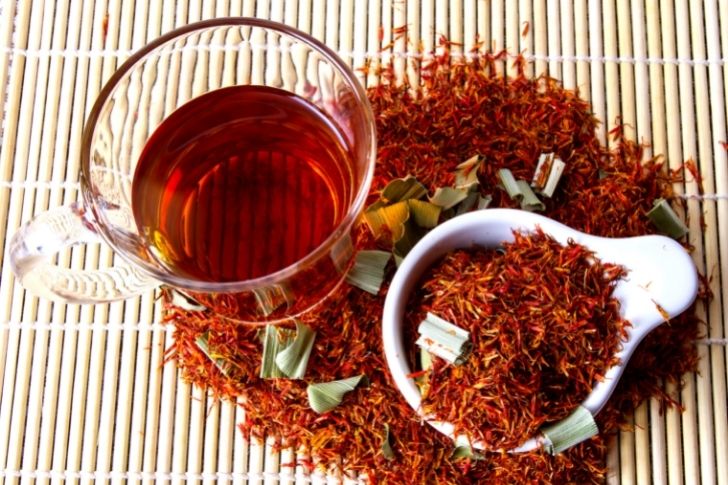
It contains high levels of linoleic acid, which makes it an ideal oil for cleaning impurities such as pimples and blackheads.
It is very quick and easy to absorb and leaves no greasy residue.
Plum Oil (or Plum Bone Oil)
– Comedogenic classification: 1 to 2
– Fatty acid compounds:
- Linoleic acid: 24%.
- Oleic acid: 67%.
Plum oil is a balanced and very moisturizing oil, which is quickly absorbed and light, so it is well tolerated by most skin types.
It is very effective in giving you improved elasticity while at the same time reducing expression lines and wrinkles.
Coconut Oil
– Comedogenic classification: 4
– Fatty acid compounds:
- Linolenic acid: 0.2%
- Linoleic acid: 1 to 3%
- Oleic acid: 5 to 8%.
- Lauric acid: 45 to 52%
Coconut oil is mainly suitable for very dry skin. Thanks to its incredible properties, it is very good for improving the appearance and beauty of the skin, as well as its health.
It softens the skin and renews the freshness of the complexion, but only in the cases of those skin that can tolerate it due to its high comedogenicity.
There are opinions that this oil should be avoided in acne-prone skin. However, scientific studies show that its high percentage of lauric acid inhibits the growth of acne-causing bacteria (Propionibacterium acnes).
It is also excellent for treating atopic dermatitis, eczema, and psoriasis.
Fractionated Coconut Oil
– Comedogenic classification: 2 to 3
– Fatty acid compounds:
- Capric acid: 36 to 47%.
- Caprylic acid: 55 to 65%
Fractionated Coconut oil, unlike pure coconut oil, is used when the solidification properties of the pure form are not desired.
It should be clarified that pure unrefined coconut oil is a fat that solidifies at temperatures below 24 degrees C, or 75 F.
On the contrary, fractionated coconut oil remains liquid at any temperature, which is why it is widely used as a massage oil and in similar preparations.
Normally this oil is suitable for dry skin types, but due to its medium comedogenicity and high caprylic and capric acid content, it can clog pores.
It has a lower comedogenic classification than extra virgin coconut oil because its long-chain triglycerides have been eliminated, making it less fatty.
Black Cumin Oil (Kalonji Oil or Nigella Sativa Oil)
– Comedogenic classification: 2
– Fatty acid compounds:
- Linolenic acid: 0.24%.
- Oleic acid: 21.7%
- Linoleic acid: 53.08%
Black Cumin oil is effective for most skin types, being especially effective in strengthening, firming, and softening skin naturally.
It has very good anti-aging properties thanks to its high content of antioxidants.
It is an oil widely used to treat eczema and psoriasis because it calms inflammation and accelerates healing.
It is also useful to help eliminate scars.
Sea buckthorn oil
– Comedogenic classification: 1
– Fatty acid compounds:
- Linoleic acid: 7%
- Oleic acid: 29%.
- Palmitoleic acid: 30%
- Palmitic acid: 31%.
Sea buckthorn oil is suitable for most skin types, but especially for the driest ones.
It helps reduce swelling, redness, and signs of premature aging.
It is an oil with the ability to penetrate very deep into the lipid layer of the skin, which allows it to reduce the imbalances of the skin from the inside out.
Sea buckthorn oil also is a great regenerator of cells and improves the structure of the skin.
Wheat Germ Oil
– Comedogenic classification: 5
– Fatty acid compounds:
- Linoleic acid: 7%
- Oleic acid: 14%.
- Linolenic acid: 55%.
Wheat Germ Oil has a very high comedogenic rating, so few people can tolerate it.
It is usually almost guaranteed that if used, an outbreak of acne will occur.
However, it is one of the oils with the best healing and anti-scarring properties of all available oils because it has a very high vitamin E content.
Pomegranate Oil (Pomegranate Seed Oil)
– Comedogenic classification: 1
– Fatty acid compounds:
- Linolenic acid: 0.5%
- Oleic acid: 5%
- Linoleic acid: 10%.
Pomegranate oil is mainly composed of omega-5 (punic acid), which makes it extraordinarily nutritious and suitable for most skin types.
This oil helps stimulate cell regeneration and reduce the signs of aging.
Also, it is one of the few vegetable sources of conjugated linoleic acid (CLA). It is good for diminishing spots and wrinkles, controlling inflammation, and improving the oxygenation of the skin.
Jojoba Oil
– Comedogenic classification: 2
– Fatty acid compounds:
- Linolenic acid: 1%
- Linoleic acid: 5%
- Oleic acid: 5 to 15%.
- Eicosenoic acid: 65 to 80%.
Jojoba oil, while well tolerated by most skin types, is very useful for oily skin as it helps balance the production of excess oils from the skin.
This oil imitates the consistency of the skin’s own sebum, making it very effective and useful for acne-prone skin.
It is also a great moisturizer and is very well absorbed by the skin.
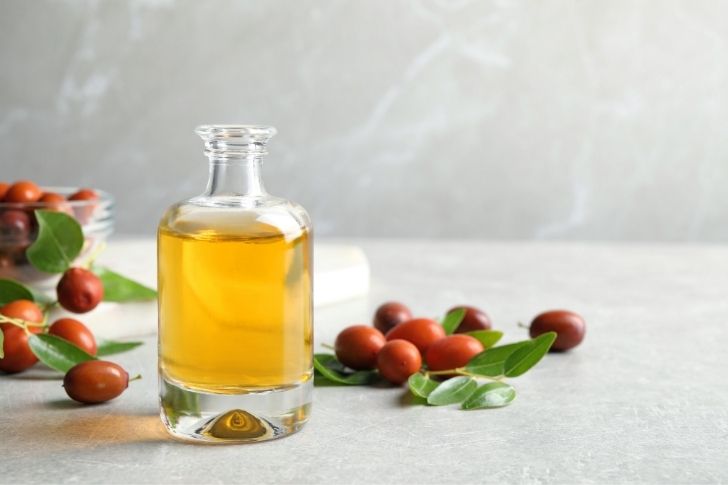
Karanja Oil
– Comedogenic classification: 2
– Fatty acid compounds:
- Linolenic acid: 3%
- Benzene acid: 4%
- Stearic acid: 8%
- Palmitic acid: 12%
- Linoleic acid: 16%.
- Oleic acid: 51%.
Karanja oil can be slightly comedogenic for more oily skin types. However, being a strong natural antiseptic, it can help prevent and cure acne breakouts.
It is also a great skin cleanser because it has very good insecticide and antiparasitic properties.
This oil is considered “the cousin of Neem oil,” so, like that oil, it is widely used to create healing ointments and balsams to remove stains and other signs of aging.
It is normally recommended to apply it in combination with other base oils.
Linseed Oil (also known as Flaxseed Oil)
– Comedogenic classification: 4
– Fatty acid compounds:
- Oleic acid: 15%
- Linoleic acid: 17%.
- Linolenic acid: 59%.
Flaxseed oil usually is not tolerated by most skin types because of its high comedogenic level, especially acne-prone skin.
However, it is a great source of essential fatty acids, as it is rich in omega-3 fatty acids, lignans, vitamins, and minerals.
Macadamia Oil
– Comedogenic classification: 2 to 3
– Fatty acid compounds:
- Linoleic acid: 1 to 5%
- Linolenic acid: 3%
- Palmitoleic acid: 15 to 22%
- Oleic acid: 55 to 67%.
Macadamia oil is commonly recommended for dry skin because it is very easily absorbed and protects it from free radical damage.
As it is highly moisturizing, it helps to keep the skin soft and nourished.
It proves to be very useful as a vehicle for transporting active ingredients such as essential oils.
Passion Fruit Oil
– Comedogenic classification: 1 to 2
– Fatty acid compounds:
- Oleic acid: 12%
- Linoleic acid: 77%.
Passion fruit oil comes from passion fruit seeds and flowers, and it is quite an exuberant oil.
It is mainly suitable for oily, acne-prone skin and proves to be a great anti-inflammatory, antibacterial, hydrating, and antioxidant. It is also very good at controlling the body’s sebum production.
It is also helpful for dry skin.
When applied topically, it produces a pleasant sensation of calm and relaxation.
Marula Oil
– Comedogenic classification: 3 to 4
– Fatty acid compounds:
- Linoleic acid: 4 to 7%
- Oleic acid: 70 to 78%
Marula oil is recommended for most skin types but is especially good for sensitive and dry skin.
It is quickly absorbed. It is nourishing and soothing, generating a pleasant sensation of relaxation and calm when applied topically.
It contains high levels of antioxidants that help fight free radicals and other environmental aggressors, in addition to reversing sun damage and reducing the signs of aging.
It is good for moisturizing and protecting the skin and improving cell regeneration.
Moringa Oil
– Comedogenic classification: 3 to 4
– Fatty acid compounds:
- Linoleic Acid: 1 to 10%
- Stearic acid: 2 to 6%
- Behenic acid: 3 to 10%.
- Palmitic acid: 5 to 13%
- Oleic acid: 50 to 78%

Moringa oil is suitable for use in mixed and dry skins, but it should be noted that it can cause acne breakouts due to its high content of palmitic, behenic, and stearic acid.
However, it is a very moisturizing oil that is absorbed very quickly and is rich in antioxidants, which protect the skin from aging.
Neem Oil
– Comedogenic classification: 1 to 2
– Fatty acid compounds:
- Linoleic acid: 13%.
- Stearic acid: 15%
- Palmitic acid: 18%
- Oleic acid: 50%.
Neem oil is suitable for drier skins but can also be used on oily skins when combined with other oils.
It is very good for preventing and treating acne thanks to its great antibacterial properties.
It is also good for reducing redness, inflammation, and irritation caused by acne while helping to moisturize and protect the skin.
Walnut Oil
– Comedogenic classification: 1 to 2
– Fatty acid compounds:
- Linolenic acid: 10%.
- Oleic acid: 30%
- Linoleic acid: 51%.
Walnut oil is recommended for most skin types.
It is especially ideal to combat dry and aged skin, as it has antioxidant and emollient properties.
It also has very good antibacterial properties, so it is effective in fighting fungi and bacteria, helping to eliminate acne.
It also decreases inflammation and redness while regenerating skin cells.
Brazil Nut Oil
– Comedogenic classification: 2
– Fatty acid compounds:
- Linolenic acid: 0.1%
- Linoleic Acid: 25 to 40%
- Oleic acid: 35 to 50%.
Brazil Nut oil is mainly suitable for dry and mature skin, thanks to its outstanding capacity to correct dryness and damage.
It is similar to jojoba oil in that it is easily absorbed and detoxifies and softens the skin, as well as helps to control hyperpigmentation.
Shea Nut Oil
– Comedogenic rating: 0 to 2
– Fatty acid compounds:
- Linoleic acid: 9 to 14%.
- Stearic acid: 9 to 27%.
- Oleic acid: 57 to 73%.
Shea Butter is an oil suitable for dry skin that, when applied, creates a barrier that protects it from dryness and helps heal wounds such as burns.
It also prevents water loss and improves the recovery of cracked skin.
Kukui Nut Oil (or Kukui Oil)
– Comedogenic classification: 2
– Fatty acid compounds:
- Oleic acid: 25%
- Linolenic acid: 26%.
- Linoleic acid: 40%
Kukui oil is recommended mainly for dry skin. It can be applied through massage with very good results, helping to revitalize the cells of tired skin, providing nutrients, and moisturizing it.
It is recommended to apply it at night because it can leave a greasy residue.
It is also very good for preventing and diminishing stretch marks and as a protection against exposure to sunlight.
Pecan Oil
– Comedogenic classification: 2
– Fatty acid compounds:
- Linoleic acid: 21%.
- Oleic acid: 41%.
The oil of the Pecan Nut is ideal for mixed skins, although it is also commonly used as a carrier oil to dilute essential oils that will be applied to dry and cracked skins.
It is also very good for facial cleansing, although it should be noted that it can leave oily or greasy residues.
Extra Virgin Olive Oil
– Comedogenic classification: 2
– Fatty acid compounds:
- Linoleic acid: 5 to 15%.
- Palmitic acid: 7 to 14%.
- Oleic acid: 63 to 80%.
Extra virgin olive oil is ideal for people with rather dry skin and who are prone to acne, as it reduces redness and inflammation caused by acne.
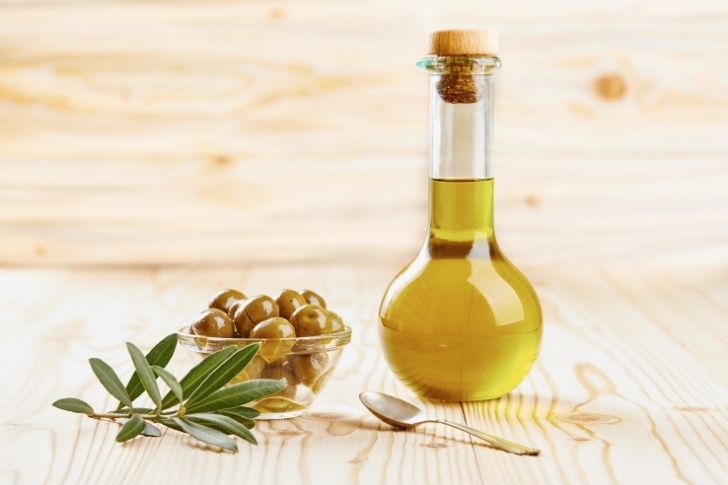
Thanks to the fact that it contains antioxidants and squalene, it is suitable for most skin types, being very nourishing and moisturizing.
It also helps to reduce the signs of aging and soften the skin.
Evening Primrose Oil
– Comedogenic classification: 2 to 3
– Fatty acid compounds:
- Oleic acid: 6%
- Gamma-linolenic acid: 11%
- Linoleic acid: 75%
Evening primrose oil can be useful for people with oily, acne-prone skin.
Also, according to studies, it helps to improve the cellular structure of the skin, reducing inflammation and promoting better elasticity.
It also helps to remove stains and eczema.
Cedar or Siberian Pine Nut Oil
– Comedogenic classification: 2
– Fatty acid compounds:
- Pinolenic acid: 17%
- Oleic acid: 24%.
- Linoleic acid: 49%.
Siberian Cedar Pine Nut oil is mainly suitable for the more oily skin types, although it is important to note that it is sometimes difficult to find.
It is excellent for treating eczema, acne, and psoriasis.
It is also good for revitalizing tired and dehydrated skin while improving texture, elasticity, and tone.
It is recommended to mix it with a carrier oil before applying it.
Castor Oil
– Comedogenic classification: 1
– Fatty acid compounds:
- Linoleic acid: 4%
- Oleic acid: 4%
- Ricinoleic acid: 90%
Castor oil is suitable for oily skin types.
It is very good as a treatment for acne, and, thanks to its ricinoleic acid content, it is a good sedative, although it is important to indicate that it should be diluted before applying it to the skin.
This oil should be used in combination with another base oil.
Rosehip Oil
– Comedogenic classification: 1
– Fatty acid compounds:
- Oleic acid: 14% to 16%
- Linolenic acid: 31% to 34%
- Linoleic Acid: 43% to 46%
Rosehip oil can be used on all types of skin, although it is more suitable for oily skin.
It is ideal for cleaning and moisturizing acne-prone skin.
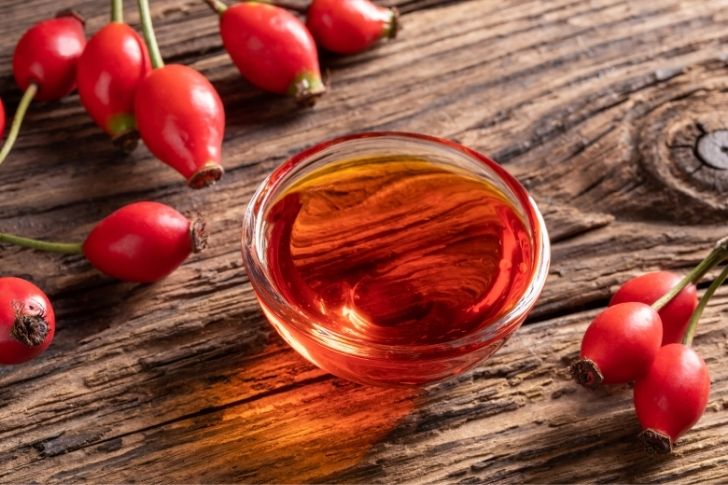
It reduces the signs of aging, stretch marks, and scars, as well as protects against sun damage because it has a high content of antioxidants, so it also helps improve skin texture.
Sacha Inchi Oil
– Comedogenic rating: 0 to 1
– Fatty acid compounds:
- Oleic acid: 7%
- Linoleic acid: 33%.
- Linolenic acid: 54%.
Sacha Inchi oil is very rich in antioxidants, making it ideal as a rejuvenator and regenerator for oily skin.
It also helps reduce irritation, inflammation, and redness while moisturizing and strengthening the skin.
It is also suitable for treating and curing acne.
Rice Bran Oil
– Comedogenic classification: 2
– Fatty acid compounds:
- Palmitic acid: 21.5%
- Linoleic acid: 34%.
- Oleic acid: 38%
Rice Bran oil is a soft oil, perfect for sensitive, delicate, or mature skin, although it is normally tolerated by most skin types.
It is one of the best natural sources of tocotrienols.
It also serves very well as a UV protector.
Sapote Oil (Sapuyul Oil)
– Comedogenic classification: 2 to 3
– Fatty acid compounds:
- Palmitic acid: 9%
- Linoleic acid: 10%.
- Stearic acid: 23%.
- Oleic acid: 50%.
Sapote oil is an oil that works very well for dry skin and is used to treat any type of dermatitis, although due to its medium to high comedogenicity, it can clog pores.
It also protects the skin from exposure to dry and cold weather.
Poppy Seed Oil
– Comedogenic rating: 0 to 1
– Fatty acid compounds:
- Oleic acid: 28.3%
- Linoleic Acid: 58.5%
Poppy Seed Oil is suitable for most skin types, but it is especially useful for those more oily because it helps regulate sebum production.
It is a light and slowly absorbed oil, which usually leaves a greasy residue.
Cranberry Seed Oil
– Comedogenic classification: 2
– Fatty acid compounds:
- Oleic acid: 20 to 25%
- Linolenic acid: 22 to 35%
- Linoleic Acid: 35 to 45%
Cranberry Seed Oil is known for its great moisturizing properties and for being an excellent emollient.
It is very well absorbed by the skin and helps maintain moisture, thus improving its texture and structure.
It is especially suitable for use on dry, irritated, and scaly skin.
Thanks to its high content of vitamin A, it is very useful for treating acne and healing and restoring inflamed tissues.
Baobab Seed Oil
– Comedogenic classification: 2
– Fatty acid compounds:
- Linolenic acid: 1 to 3%
- Linoleic acid: 24 to 34%.
- Oleic acid: 30 to 40%
Baobab Seed Oil is ideal for use on mixed skins as it has little chance of clogging the pores, although it is also suitable for dry and damaged skin.
It is easily and quickly absorbed, improving the appearance, elasticity, and texture of the skin.
It is also a very good painkiller.
Pumpkin Seed Oil
– Comedogenic classification: 2
– Fatty acid compounds:
- Linolenic acid: 0.2%
- Oleic acid: 36.3%
- Linoleic Acid: 47%.
Pumpkin Seed Oil is very good for preventing and treating acne because it helps fight the bacteria that cause it, as it is an excellent natural antibacterial.
It can normally be used on most skin types.
It is also a great moisturizer and firming oil.
Cherry Seed Oil
– Comedogenic classification: 2
– Fatty acid compounds:
- Linoleic acid: 42%
- Oleic acid: 46%.
Cherry Seed Oil is suitable for use on most skins, but mainly on somewhat dry skins.
It is well absorbed, and its high phytosterol content makes it excellent for reducing irritation, inflammation, and redness.
Chia Seed Oil (or Chia Oil)
– Comedogenic classification: 3
– Fatty acid compounds:
- Oleic acid: 7.7%
- Linoleic Acid: 18.7%
- Linolenic acid: 61%.
Chia oil is ideal for treating sensitive or often dry skin. It can also be used as a moisturizing mask for dry skin.
Due to its high omega-3 content and average comedogenic classification, pore-clogging is possible if applied topically.
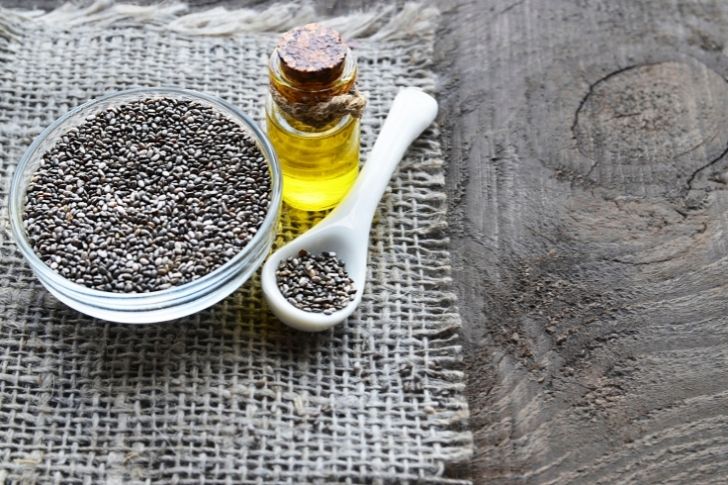
Peach Seed Oil
– Comedogenic classification: 2
– Fatty acid compounds:
- Palmitic acid: 5 to 8%.
- Linoleic acid: 15 to 35%
- Oleic acid: 55 to 75%
Peach Seed Oil is good for people with dry and sensitive skin because it is emollient and nourishes and moisturizes the skin very well, without leaving it greasy.
It is very rich in vitamin E, which makes it perfect for skin care.
Black Raspberry Seed Oil
– Comedogenic classification: 1 to 2
– Fatty acid compounds:
- Oleic acid: 10.5 to 18%
- Linolenic acid: 28%
- Linoleic acid: 48%.
Black Raspberry Seed Oil is very good for both dry or mixed skin prone to acne and for mature and sensitive skin.
It is a very good moisturizer, helping to keep the skin smooth and soft, improving its elasticity, and protecting it from damage or oxidative stress, as well as protecting it from free radicals.
Strawberry Seed Oil
– Comedogenic classification: 1
– Fatty acid compounds:
- Oleic acid: 12 to 18%
- Linolenic acid: 30 to 38%
- Linoleic acid: 35 to 50%.
Strawberry Seed Oil is especially good for skin types prone to oily acne. It can also be used for skin that is damaged, mature, and/or sensitive, as it moisturizes, softens, and protects while helping to regenerate elasticity.
You can take advantage of it by adding it to homemade skincare products or applying it directly to the skin, thanks to its excellent benefits and moisturizing properties.
Sunflower Seed Oil
– Comedogenic rating: 0 to 2
– Fatty acid compounds:
- Linolenic acid: 0.5%
- Oleic acid: 30%
- Linoleic acid: 59%.
Sunflower seed oil is an oil that most skin types normally respond well to.
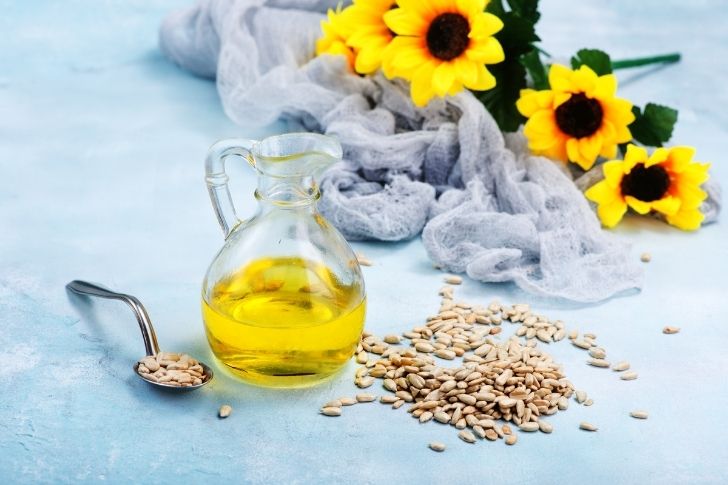
It helps keep the skin hydrated while fighting the bacteria that cause acne. It also has anti-inflammatory properties.
It also has very good anti-aging qualities.
This is a fairly safe oil for people who are starting to use vegetable oils.
Goji Seed Oil (also known as Goji Berry Oil)
– Comedogenic rating: 0 to 1
– Fatty acid compounds:
- Linolenic acid: 3%
- Oleic acid: 19%.
- Linoleic acid: 68%.
Goji seed oil is very good for oily skin.
It is a light oil with great emollient properties, so it is usually used around the eye area, being a good reaffirming agent.
It helps detoxify the skin and open up clogged pores.
It also improves intercellular oxygenation, optimizing the balance between water and fat in the skin.
Black Currant Seed Oil
– Comedogenic rating: 0 to 1
– Fatty acid compounds:
- Gamma-linolenic acid: 14%
- Oleic acid: 15%
- Alpha-linolenic acid: 17%
- Linoleic acid: 41%.
Black currant seed oil is very beneficial for dry, damaged, devitalized, and/or sensitive skin.
It helps to cure rosacea, eczema, seborrheic dermatitis, and psoriasis because it is a good skin regenerator and also calms inflammatory conditions.
Guava Seed Oil
– Comedogenic classification: 1 to 2
– Fatty acid compounds:
- Linolenic acid: 0.7%
- Oleic acid: 11%.
- Linoleic acid: 77%.
Guava Seed Oil is very useful for most skin types, helping, among other things, to reduce pores and tighten and tone the skin.
It is also a great anti-aging and cures scars and stretch marks as it prevents moisture loss.
It works excellently combined with other carrier oils and is a great emollient that gives the skin a very pleasant feeling and appearance of softness and elasticity.
Kiwi Seed Oil
– Comedogenic classification: 1
– Fatty acid compounds:
- Oleic acid: 13%
- Linoleic acid: 16%.
- Linolenic acid: 63%.
Kiwi seed oil is good mainly for dry and flaky skin types that need to maintain moisture.
Its high content of alpha-linoleic enables the elimination of dead skin cells, helping to leave more flexible and smooth skin.
It is recommended to use it in the colder months as a protector against dry skin.
It can be used as an additional oil to other base oils or only as a localized treatment.
Mango Seed Oil (or Mango Oil)
– Comedogenic classification: 2
– Fatty acid compounds:
- Linoleic acid: 4%
- Stearic acid: 40 to 45%
- Oleic acid: 40 to 46%.
Mango Seed Oil is very good for dry skin, especially for those who are prone to acne.
It helps reduce redness and inflammation and is a good protector for very sensitive skin.
Blackberry Seed Oil
– Comedogenic rating: 0 to 1
– Fatty acid compounds:
- Linolenic acid: 15%
- Oleic acid: 15.1%
- Linoleic acid: 62.7%
Blackberry seed oil is a great moisturizer and emollient because it has a unique combination of essential fatty acids and antioxidants.
This also makes it good for fighting skin spots and skin aging, as well as decreasing the size of pores.
It is especially suitable for the oiliest skin types.
Palm Seed Oil
– Comedogenic classification: 4
– Fatty acid compounds:
- Linoleic acid: 2.3%
- Oleic acid: 15%
- Lauric acid: 48%
Palm Seed Oil is mainly suitable for very dry skin.
Its texture and feel are similar to those of coconut oil.
It promotes a brighter and smoother appearance of the skin since it moisturizes it deeply.
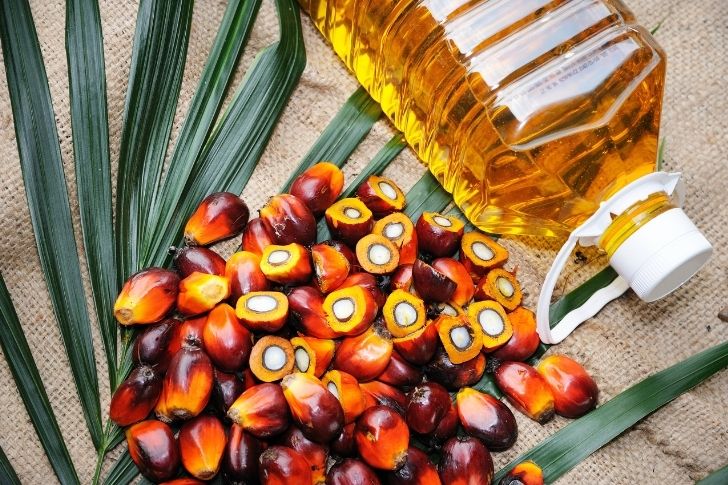
Papaya Seed Oil
– Comedogenic classification: 2 to 3
– Fatty acid compounds:
- Linoleic acid: 3%
- Palmitic acid: 14%.
- Oleic acid: 77%.
Papaya Seed Oil is excellent for dry, acne-prone skin, thanks to its light exfoliation.
It also relieves dry skin conditions, reduces pores, and unifies skin tone.
It is also a great antioxidant and helps improve the appearance of the skin and decrease wrinkles. At the same time, it promotes cell regeneration.
Cucumber Seed Oil
– Comedogenic classification: 1
– Fatty acid compounds:
- Linolenic acid: < 1%
- Oleic acid: 14 to 20%
- Linoleic acid: 60 to 88%
Cucumber Seed Oil is good for most skin types.
It helps strengthen the skin’s lipid barrier, promoting smoother skin and improving its elasticity.
It is good to protect it from the sun’s rays and is a great anti-aging oil, as well as preventing and effectively treating acne.
It also nourishes and stimulates the regeneration of cells, being excellent for treating redness, inflammation, and rough areas.
Spiny Pear Seed Oil
– Comedogenic classification: 1 to 2
– Fatty acid compounds:
- Stearic acid: 4%
- Palmitic acid: 12%
- Oleic acid: 22%
- Linoleic acid: 60%.
Spiny Pear Seed Oil is especially good for oily skin. It also works well on normal, mixed, and dry skin, even though it is not a very moisturizing oil.
It helps to reduce pores and tighten the skin because it is a great emollient and gives it a soft and velvety appearance.
Its continuous use helps restore its elasticity and decreases the signs of aging.
Grapefruit Seed Oil
– Comedogenic classification: 2
– Fatty acid compounds:
- Stearic acid: 1 to 4%
- Oleic acid: 18 to 25%
- Palmitic acid: 26 to 36%.
- Linoleic Acid: 32 to 40%
Grapefruit Seed Oil is a light oil known for its excellent healing and regenerative properties.
It is mainly useful for oily, acne-prone skin.
Improves skin elasticity and reverses chronic dryness by exfoliating dead skin cells and diminishing the appearance of wrinkles.
Grapefruit Seed Oil is usually recommended to be used mixed with another carrier oil.
Watermelon Seed Oil
– Comedogenic rating: 0 to 1
– Fatty acid compounds:
- Oleic acid: 15%
- Linoleic acid: 63%.
Watermelon oil is especially good for acne-prone skin but also restores elasticity to dry and mature skin.
In fact, due to its low comedogenicity, it does not clog pores, so it is recommended for most skin types.
It is quickly absorbed and does not leave a greasy feeling. Besides dissolving the sebum, it is very good for eliminating impurities such as pimples and blackheads.
Elderberry Seed Oil
– Comedogenic classification: 1 to 2
– Fatty acid compounds:
- Oleic acid: 8 to 12%
- Linolenic Acid: 35 to 45%
- Linoleic acid: 43%.
Elderberry Seed Oil is suitable for acne-prone skin because it has a decongestant effect on the skin.
It also has a high content of antioxidants that make it a good anti-aging compound, and it also promotes good skin elasticity.
When applied, it leaves a silky smooth feel and prevents water and moisture loss.
Tomato Seed Oil
– Comedogenic rating: 0 to 2
– Fatty acid compounds:
- Linolenic acid: 2%
- Oleic acid: 21%.
- Linoleic acid: 49%.
Tomato Seed Oil is suitable for most skin types.
It is a great source of antioxidants and vitamin E. It helps protect the skin from free radicals and sun rays and is also very good for moisturizing and improving the skin’s appearance.
It helps increase elastin production and prevents collagen degradation.
It is very useful for treating acne and diminishing wrinkles.
Grape Seed Oil
– Comedogenic classification: 1
– Fatty acid compounds:
- Oleic acid: 21%.
- Linoleic acid: 63 to 72%
Grape Seed Oil is suitable for most skin types and, due to its low comedogenicity, has very little chance of clogging or plugging pores.
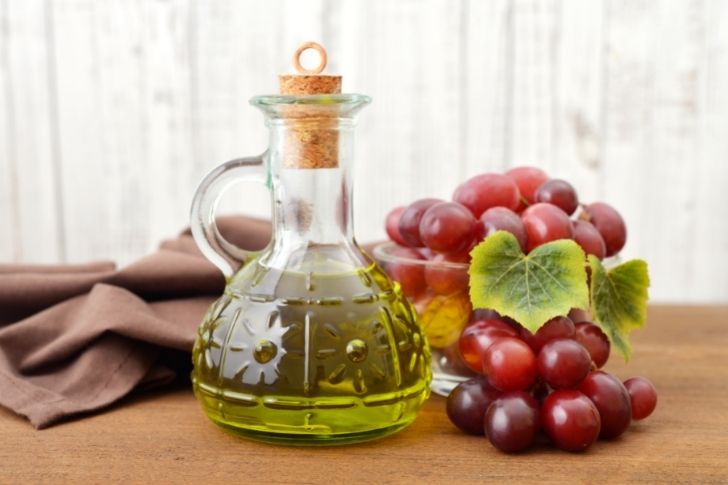
It is very rich in vitamin E, so it helps moisturize and tighten the skin.
It is good for treating acne and reducing inflammation and redness.
It is very easily absorbed and leaves no greasy residue.
Carrot Seed Oil
– Comedogenic classification: 3 to 4
– Fatty acid compounds:
- Linolenic acid: 0.2%
- Linoleic acid: 10.8%
- Oleic acid: 68.4%
Carrot oil is not suitable for acne-prone skin due to its high oleic content.
But for those skins that can endure it, it provides a substantial improvement in tone, appearance, and elasticity.
It also has very good anti-aging properties and also helps to soothe irritated skin.
Cloudberry Seed Oil
– Comedogenic classification: 1
– Fatty acid compounds:
- Stearic acid: 1.4%
- Palmitic acid: 3%
- Oleic acid: 16%.
- Linolenic acid: 34%.
- Linoleic acid: 43%.
Cloudberry oil is a perfect oil for acne-prone and oily skin.
It is very rich in nutrients, helping to keep the skin bright and healthy.
In addition, because it has a high amount of linolenic acid, it prevents dead skin cells from clogging the pores, which is why it is good for treating acne.
It is recommended to use it in combination with another vehicle or carrier oil.
Sesame Oil
– Comedogenic classification: 3
– Fatty acid compounds:
- Stearic acid: 4%
- Oleic acid: 39%.
- Linoleic acid: 42%
Sesame oil (sesame) is normally good for mixed, dry, and aged skins.
It has superb antibacterial properties that make it ideal for healing wounds and fighting bacteria that cause acne. It is also a good sunscreen.
Although it contains stearic acid, it can be a bit comedogenic for some people.
Soybean Oil
– Comedogenic classification: 4 to 5
– Fatty acid compounds:
- Linolenic acid: 7%
- Oleic acid: 24%.
- Linoleic acid: 50%.
Soybean oil is highly comedogenic, so most skins do not tolerate it.
However, for those with skin that can tolerate it, it can be a very good oil for improving skin tone and protecting against UV rays.
It also has very good antioxidant properties.
Oil of Tamanu or Calophyll
– Comedogenic classification: 2
– Fatty acid compounds:
- Oleic acid: 31-44%.
- Linoleic acid: 20-38%
- Stearic acid: 13-20%%.
- Palmitic acid: 12-18%
- Linolenic acid: < 1%
Tamanu oil is suitable for most skin types, especially scarred or dry, sensitive skin.
It is the best oil to cure and improve acne scars.
Its unique chemical composition gives it powerful antibacterial and anti-inflammatory properties, making it excellent for conditions such as rosacea, dermatitis, eczema, and other skin diseases that should be avoided.
It is a great moisturizer that repairs and regenerates skin cells. Powerful anti-wrinkle, the oil of tamanu oil is ideal against aging and for mature skin. In addition, it softens rough skin.
Because of its thick consistency and pungent odor, it is best used as a spot treatment for problem areas or mixed with other carrier oils.
Conclusions
I hope that with this list and the description of each oil, its comedogenic classification, and fatty acid composition, you will be clearer about which oil you should use in your particular case.
Remember to always keep your skin pores from clogging up in a way that prevents resulting problems such as acne.
Organic and natural oils are becoming increasingly popular, and there is a good reason for this:
They are safer and more effective than many of the cosmetic products available on the market.
When using artificial industrial cosmetics, a number of chemicals are introduced into the body through the skin, which can often be very harmful.
That is why comedogenic and non-comedogenic natural vegetable oils are a good option since they are safe, healthy, and have the same and even better properties and benefits than industrial cosmetic products.
I hope this list of the most effective comedogenic oils for your skin care will help you choose the best oil(s) for you.
If you liked this post, please share it. Save THIS PIN below to your Natural Oils board on Pinterest and check it later! 🙂
